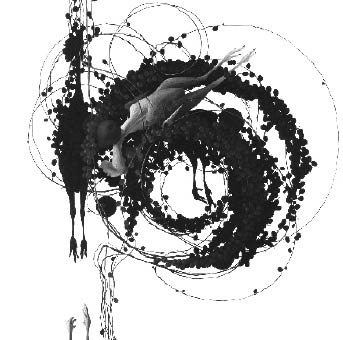Fantasy in Realism
by Albert Chao

In Mel Stuart’s film Willy Wonka and the Chocolate Factory, a lickable fruit wallpaper demonstrates Willy Wonka’s wild, seemingly impossible yet creative mind for invention:
Willy Wonka: The strawberries taste like strawberries. The snozzberries taste like snozzberries.
Vercua Salt: Snozzberries? Who ever heard of a snozzberry?
Willy Wonka: “We are the music makers…and we are the dreamers of dreams.”
Wonka’s “factory” is where magic happens. A touch of this, a dab of that, and something brilliant is produced. Wonka’s revolutionary inventions, however, are not all perfect, and not all experimentations are resolved.
Like Wonka’s revolutionary wallpaper, oil paintings of luscious grapes dangling from intertwining vines in Mia Brownell’s exhibition Complexities of the Garden at Big Orbit Gallery tempt both touch and taste. With beautiful technique, her images visually pop off the canvas. The seemingly tangible fruit, however, becomes too real and thus resonates a hyper-real quality. With brilliant finesse and skill, Brownell subtly exposes the modern food factory as the complex duality between the artificial and the natural.
Writhing, dynamic and active are adjectives that define Mia Brownell’s “still lifes.” She follows a tradition of still-life painting that became prominent in Dutch 16th- and 17th-century painting. Contrasting to other more traditional still lives, her images float in intertwined abstract arrangements, either on an off-white blank or dark black canvas. The vines and grapes, most prominent in this series of paintings, move endlessly and are uncontained by table or basket.
In some paintings, the grape vines intertwine to form scientific models of proteins, most noticeable in the double helix of Still Life with Thoughts of Jelly. Brownell alludes to the artificial nature of scientific effects on the natural. Biological advances have allowed for foods to be made, in general, more resilient and more plentiful. In all her paintings, her fruit, including mostly grapes and pears, are presented as an ideal: There are no bruises, no signs of imperfection, and they are overabundant. She, in fact, refers to her interest in the perfect arrangement and display of foods in her artist’s statement:
“I’m not into agriculture or gardening, but every supermarket I walk into, wherever in America, I am transported to a unique place without seasons. Walls and pyramids of perfectly lit produce stop time and quote biblical notions of Eden. The whole concept of not having a winter is a little absurd, no matter how amazing it looks. The synthesis of these natural and artificial states creates an ambiguity that I find captivating.”
Through intense chiaroscuro with the objects, Brownell also establishes a figure and ground, integrating object with shadow. Still Life with Flu highlights certain grapes and pears with intensity while swans are casted in shadow and blend into the background. This pairing of animal and fruit generates an uneasy queasiness and raises the controversy and debate of gene splicing. What are we actually eating with genetically altered foods?
Brownell also integrates chickens with her paintings in Still Life with Chicken Villin Headpiece. A plucked chicken lies motionless within the swirls of grapes and pears. Hiding in the shadows, a body of a plucked chicken with the head cropped off by the top of the canvas dangles lifelessly as if hung by vines. In the bottom of the painting, only the feet, the rest of the body cropped by the canvas, stays in the light. Again, like in Still Life with Flu, the relationship between light and shadow creates an even greater figure/ground tension.
Just as Willy Wonka quotes 19th-century British poet Arthur O’Shaughnessy, Mia Brownell is both creator and visionary: “We are the music makers,/ and we are the dreamers of dreams.” Like the artificial nature of Wonka’s inventions including snozzberries, Brownell’s dynamic paintings are manipulated and recreated to blur the lines between reality and fantasy. She invokes irony in her paintings, displacing the artificial for the real and ultimately raises important questions in modern day practice in the marketplace.
Mia Brownell’s exhibition Complexities of the Garden will continue until December 23 at the Big Orbit Gallery, located at 30D Essex Street. The gallery is open Thursday through Sunday, 12-5pm.
Design Matters is presented in association with the UB School of Architecture and Planning and supported by a fellowship endowed by Polis Realty.
|
Issue Navigation> Issue Index > v5n48: Gray Anatomy (11/30/06) > Fantasy in Realism This Week's Issue • Artvoice Daily • Artvoice TV • Events Calendar • Classifieds |









 Current Issue
Current Issue